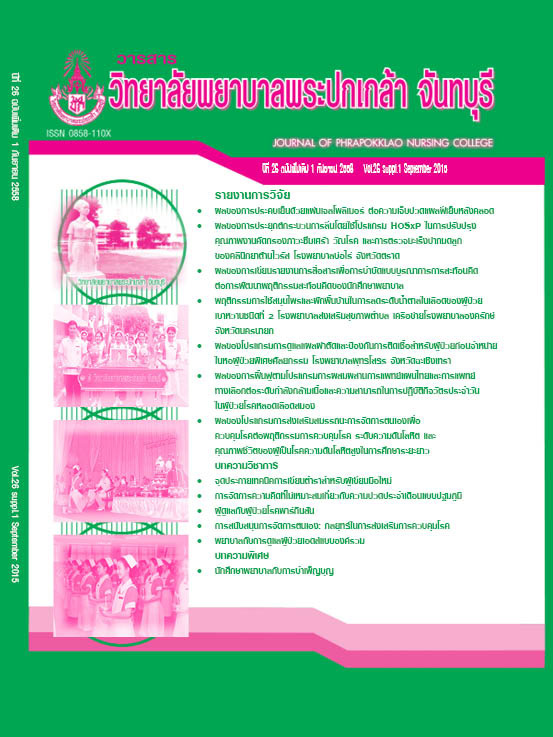The Effect of Cold Polymer Gel Pack Compression on Postpartum Perineal Pain
Keywords:
Perineal pain, Cold compression, Polymer gel packAbstract
This clinical trial research aimed to study the effect of cold polymer gel pack compression on perineal pain in postpartum period. The study was conducted with 44 postpartum mothers with 2nd degree perineal tear who gave birth at Ban Kruat Hospital, Buriram Province. A block randomization method was used to select 22 participants to be in the experimental group to receive the cold compression on perineum by using polymer gel pack together with usual nursing care. Another group of 22 participants was in the control group using polymer gel pack which was not cold to compress on perineum. The research tools were composed of a polymer gel pack, a handbook of cold polymer gel pack compression, a questionnaire of demographic and labor data, and the numerical rating scales for perineal pain measurement with the reliability of .86. The perineal pain was assessed for 5 times: before the compression, immediately after receiving the compression, 30 minutes after the compression, 1 hour and 2 hours after the compression, respectively. The intervention was implemented and the data were collected from October 2014 to January 2015. Statistics used for data analysis included frequency, percentage, mean, standard deviation, paired t-test, and independent t-test.
The study was revealed as follows:
1. The average perineal pain scores of the group receiving the cold compression after receiving the compression immediately, 30 minutes after the compression, 1 hour and 2 hours after the compression, were less than those of before receiving the compression statistically significant (t = 7.492, p < .001; t = 5.159, p < .001; t = 4.365, p < .001, and t = 5.159, p < .001, respectively).
2. The average perineal pain scores of the group receiving the cold compression after receiving the compression immediately, 30 minutes after the compression, 1 hour and 2 hours after the compression, were less than those of the group using polymer gel pack which was not cold statistically significant (t = 3.200, p < .01; t = 2.317, p < .05; t = 1.806, p < .05, and t = 2.304, p < .05, respectively).
This study suggested that cold polymer gel pack compression should be used to relive perineal pain in postpartum mothers.
References
งานห้องคลอด โรงพยาบาลบ้านกรวด จังหวัดบุรีรัมย์. (2556). สถิติผู้คลอดที่ได้รับการตัดฝีเย็บ พ.ศ. 2554-2556.
ชูศรี พิศลยบุตร, และพงษ์ธารา วิจิตรเวชไพศาล. (บ.ก.). (2543). วิสัญญีวิทยาทางสูติกรรม. กรุงเทพฯ: พี เอ ลีฟวิ่ง.
ธนวัลย์ เตชทรัพย์อมร. (บ.ก.). (2540). การรักษาด้วยความร้อน เย็น แสง เสียง 1. เชียงใหม่: ภาควิชากายภาพบำบัด คณะเทคนิคการแพทย์ มหาวิทยาลัยเชียงใหม่.
เนาวรัตน์ แกว่นกสิการณ์. (2551). ผลของการนวดฝีเย็บต่อการบาดเจ็บของฝีเย็บในการคลอดปกติ (วิทยานิพนธ์ปริญญามหาบัณฑิต). มหาวิทยาลัยเชียงใหม่.
พงศ์ภารดี เจาฑะเกษตริน, และคณะ. (2547). ความปวด. กรุงเทพฯ: เมดิมีเดีย (ประเทศไทย).
ภัสรา หากุหลาบ, และนันทวรรณ ธนาโนวรรณ. (2552). อุปสรรคของการเริ่มให้ลูกดูดนมแม่ครั้งแรกในห้องคลอด. วารสารการพยาบาล, 24(2), 14-23.
ศศิกานต์ นิมมานรัชต์. (2553). ความปวดและการระงับปวดในเวชปฏิบัติ. สงขลา: ชานเมืองการพิมพ์.
สมาคมการศึกษาเรื่องความปวดแห่งประเทศไทย. (2552). แนวทางพัฒนาการระงับปวดเฉียบพลัน (Clinical guidance for acute pain management). กรุงเทพฯ: ผู้แต่ง.
สุภา ศรีวสุกาญจน์, ทัศนีย์ พฤกษาชีวะ, และวรพรรณ ผดุงโยธี. (2547). ผลการลดความปวดของแผลฝีเย็บของมารดาครรภ์แรกคลอดปกติระหว่างวิธีแช่แผลฝีเย็บด้วยน้ำอุ่นและน้ำเย็น. รามาธิบดีพยาบาลสาร, 10(3), 184-192.
อารีณา ภานุโสภณ, สุจินตนา พันธ์กล้า, เยาวลักษณ์ เลาหะจินดา, และสมาน ภิรมย์สวัสดิ์. (2541). เปรียบเทียบผลการลดความเจ็บปวดแผลฝีเย็บภายหลังคลอดระหว่างวิธีประคบด้วยความเย็นและประคบด้วยความร้อน. รามาธิบดีเวชสาร, 14(2), 132-135.
Albers, L. L., & Borders, N. (2007). Minimizing genital tract trauma and related pain following spontaneous vaginal birth. Journal of Midwifery & Women’s Health, 52(3), 246-253.
Aytan, H., Tok, E. C., Ertunc, D., Yasa, O. (2014). The effect of episiotomy on pelvic organ prolapse assessed by pelvic organ prolapse quantification system. European Journal of Obstetrics & Gynecology and Reproductive Biology, 173, 34-37.
Cunningham, F. G., et al. (2010). Williams obstetrics (23nd ed.). New York: McGraw-Hill.
D’Arcy, Y. M. (2007). Pain management: Evidence-based tools and techniques for nursing professionals. Marblehead, MA: HCPro.
East, C. E., Sherburn, M., Nagle, C., Said, J., & Forster, D. (2012). Perineal pain following childbirth: Prevalence, effects on postnatal recovery and analgesia usage. Midwifery, 28(1), 93-97.
Fernando, R. J. (2007). Risk factors and management of obstetric perineal injury. Obstetrics, Gynaecology and Reproductive Medicine, 17(8), 238-243.
Lam, K. W., Wong, H. S., & Pun, T. C. (2006). The practice of episiotomy in public hospitals in Hong Kong. Hong Kong Medicine Journal, 12(2), 94-98.
Leventhal, L. C., de Oliveira, S. M. J. V., Nobre, M. R. C., & da Silva, F. M. B. (2011). Perineal analgesia with an ice pack after spontaneous vaginal birth: A randomized controlled trial. Journal of Midwifery & Women’s Health, 56(2), 141-146.
Macarthur, A. J., & Macarthur, C. (2004). Incidence, severity, and determinants of perineal pain after vaginal delivery: A prospective cohort study. American Journal of Obstetrics and Gynecology, 191(4), 1199-1204.
Melzack, R., & Wall, P. D. (1965). Pain mechanisms: A new theory. Science, 150(3699), 971-979.
Oliveira, S. M. J. V., Silva, F. M. B., Riesco, M. L. G., Latorre, Mdo. R., & Nobre, M. R. C. (2012). Comparison of application times for ice packs used to relieve perineal pain after normal birth: A randomised clinical trial. Journal of Clinical Nursing, 21(23-24), 3382-3391.
Sheikhan, F., Jahdi, F., Khoie, E. M., Alizadeh, N. S., Sheikhan, H., Haghani, H. (2011). Episiotomy discomforts relief using cold gel pads in primiparaus iranian women. Research Journal of Medical Sciences, 5(3), 150-154.
Williams, A., Herron-Marx, S., & Knibb, R. (2007). The prevalence of enduring postnatal perineal morbidity and its relationship to type of birth and birth risk factors. Journal of Clinical Nursing, 16(3), 549-561.
Yusamran, C., Titapant, V., & Kongjeera, A. (2007). Relief perineal pain after perineorrhaphy by cold gel pack pad: A randomized controlled trial. Thai Journal of Nursing Research, 11(2), 87-95.
Downloads
Published
How to Cite
Issue
Section
License
Copyright (c) 2015 Journal of Phrapokklao Nursing College

This work is licensed under a Creative Commons Attribution-NonCommercial-NoDerivatives 4.0 International License.
เนื้อความ ข้อมูล และรายการอ้างอิงที่ผู้เขียนใช้ในการเขียนบทความเพื่อลงตีพิมพ์ในวารสารวิทยาลัยพยาบาลพระปกเกล้า จันทบุรี ถือเป็นความคิดเห็นและความรับผิดชอบของผู้เขียน คณะผู้จัดทำวารสารไม่จำเป็นต้องเห็นพ้องด้วยหรือร่วมรับผิดชอบ
บทความที่ได้รับการลงตีพิมพ์ในวารสารวิทยาลัยพยาบาลพระปกเกล้า จันทบุรี ถือเป็นลิขสิทธิ์ของวารสารวิทยาลัยพยาบาลพระปกเกล้า จันทบุรี หากหน่วยงานหรือบุคคลใดต้องการนำส่วนหนึ่งหรือทั้งหมดของบทความไปเผยแพร่ต่อเพื่อวัตถุประสงค์ใด ๆ จะต้องได้รับอนุญาตจากบรรณาธิการวารสารก่อน



